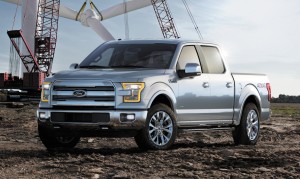As the most patriotic of holidays – Independence Day – approaches, it may come as a shock to discover that if you want to buy an “American” car, you may need to go to a Toyota or Honda dealership.
Cars.com released its annual list of “Most American” vehicles and once again, the Ford F-150 topped the list. However, the Toyota Camry placed second for the second year in a row. In fact, four of the top six “American” cars are Toyotas, according to the website.
The list reflects the levels of American-made parts on new vehicles. The vehicles on the list have an American-made parts content of 75% or more. For the 2014 model year, just 13 models assembled in the U.S. have domestic-parts content of 75% or higher, according to the National Highway Traffic Safety Administration, but three of those were disqualified because they’re being discontinued.
In the 2013 model year, 14 cars met that threshold. Twenty cars met the threshold in the 2012 model year, and 30 cars met it in2011. In short, figuring out what constitutes an “American” car isn’t so easy these days.
(Chrysler recalls nearly 700,000 minivans. For more, Click Here.)
“Many cars built in the U.S., for example, are assembled using parts that come from elsewhere,” said Kelsey Mays, Cars.com consumer affairs editor, in a release. “Some cars assembled in the U.S. from largely American-made parts don’t sell well, meaning fewer Americans are employed to build them.”
(Click Here for details about Versa, Ram investigations by NHTSA.)
The top 10 American vehicles are:
- Ford F-150
- Toyota Camry
- Honda Odyssey
- Toyota Sienna
- Toyota Tundra
- Toyota Avalon
- Chevy Corvette Stingray
- Honda Ridgeline
- Honda Crosstour
- Dodge SRT Viper
The Corvette, Ridgeline, Crosstour and Viper are new to the list this year and are making their first appearance ever. GM’s trio of seven-passenger crossover vehicles – Chevy Traverse, GMC Acadia and Buick Enclave – have always had a spot on the list in the past, but didn’t make the cut this year because their parts content dropped below 75%.
(To see more about GM’s latest round of recalls, Click Here.)
Additionally, the Dodge Avenger was on the list last year, but since it was discontinued and has no immediate successor, it was eliminated from consideration.


Its getting more difficult to buy American. I never knew the Big Three imported parts rather than buy from US manufacturers.
If they (Big Three) _were buy in the US, it would make thousands more jobs here in America.
I’m going to write to all of them and express my
displeasure with their practices.
Thank you for pointing this out.
Hey Tinsley, if they didn’t buy cheaper parts from other places besides the US a basic car would cost like $75,000. Think about that. It’s sad but true.
Matt, you are an idiot. If your assumption on the $75k car were right, then how are 8/10 on the list well below that mark? And the two above are high end performance cars. It is a union issue that non US makers are against, ironically, their employees are taken care if as well, if not better.
Yep – and we keep on giving the big three tax breaks so they can create jobs!
We really need to penalize ANY American corporation that either buys their parts or creates jobs overseas rather than giving them tax breaks!
It use to be that the auto industry accounted for 70% of the GDP once you included all of the suppliers. Now according to a news article it accounts for more of the United States of Mexico. Don’t feel sorry for the auto makers, they have destroyed their market since most to the people now supplying and building vehicles can no longer purchase them. New that Nissan and Daimler will build a new plant in Mexico but the wages are below China’s.
No company operating in the United States of America should receive tax incentives or tax payer funded subsidies if the percentage of their employees is less than 100% US Citizens. The excuse that there are not enough qualified individuals is only a lame excuse to outsource. There are currently 20 USA applicants for every open job requisition. For a Sr Business Analyst in the USA it costs $75/hr and in India it is $22/hr. The difference, no health care or safety regulations in India. That means, companies do not want quality health care for working class people in their communities…just high profits for themselves. They should delete their mission statements.
Hi, Julie,
Would you likewise be okay if foreign countries effectively put barriers in place to the employment of Americans? There are many thousands of U.S. white-collar employees based in Europe and in China, among other parts of the automotive world. Also, would you call for steps to balance out the pricing of a Hyundai that might have the advantage of lower home labor costs, as well as a weak currency, so that a Ford or GM could be competitive using 100% American labor? Would you be comfortable spending $1000s more? (Does your home have American-made appliances, etc.?) I am not dismissing your concerns outright but the issue is more complex than a simple, one-paragraph “solution.”
Paul A. Eisenstein
Publisher, TheDetroitBureau.com